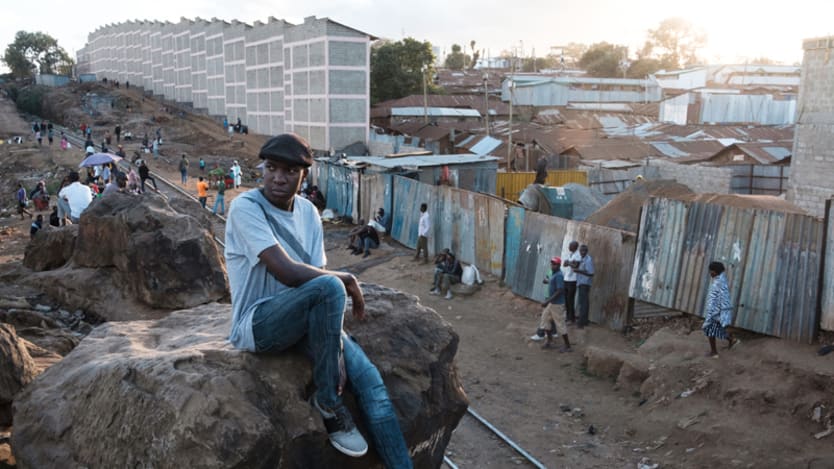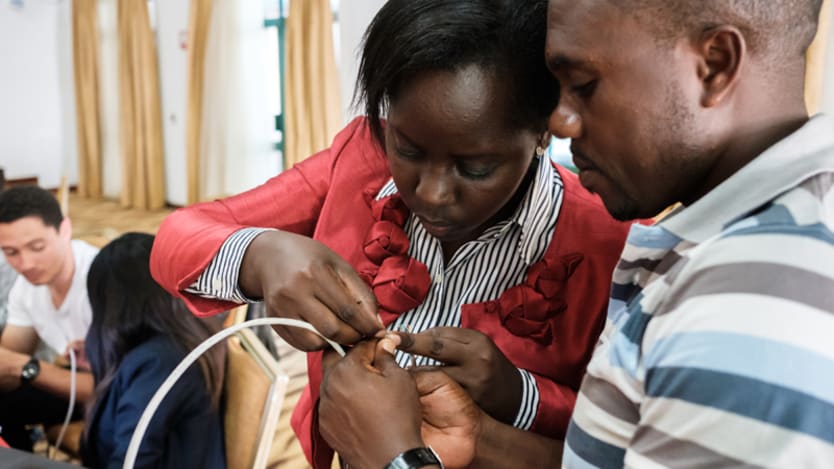
By 9 a.m., the sun is already bright in Laini Saba, a village in Kibera, Africa’s largest urban slum. Moses Otieno has only been asleep a few hours, but the 24-year-old wakes up and looks for breakfast. He finds two chapatis that he buys for 50 shillings ($0.5) on the busy nearby street, full of food vendors.
Otieno works overnight as a cleaner in a Nairobi mall, and usually reports to work at dusk and leaves at dawn. After sleeping a few hours and having breakfast, he walks to a friend’s print shop, packed with clients seeking photocopy, typing, scanning or printing services. Sometimes, customers ask for graphic design, and those jobs to go Moses. In a good month, he makes around 5,000 shillings ($48) here.
Clients are happy with Otieno’s work, though he has no degree or formal training. Higher education in Kenya is prohibitively costly for many young people in Kibera. Otieno is self taught and usually designs on his phone.
Kibera may soon have a new resource for young people like Otieno, who want to study but can’t afford conventional college courses. Tunapanda, a technical training institute, has launched a community network called Tunapandanet, that connects several computer centers to its servers, allowing them access to training materials and tutorials without the usual costs of using the internet.
See more related topics:
► How to fill the gaps in the response to the digital divide
► Opinion: Localizing the global goals — putting tech to use for governments
► Cultural barriers need to be challenged to close the gender digital divide
► Rwanda's 'solar smart kiosk' provides digital solutions to rural mobile phone users
Tunapanda Institute already offers training in programming, entrepreneurship and graphic design, but its reach is limited to 25 students every three months, with three intakes every year. According to Josephine Miliza, the partnerships lead at Tunapanda, the institute receives thousands of applications for those limited slots every year.
Tunapandanet could expand access. The so-called community network would be the first Kenyan example of a technology increasingly popping up across Africa. Built and managed locally, these networks offer the community the opportunity to craft content to their needs. The networks operate on an intranet, so they generally far less costly compared to regular internet service.
Advocates see community networks as a vital tool in connecting the next billion, though there are still challenges for now. A lack of electricity, limited skill sets and funding are among the obstacles that have so far limited the networks’ use. But if successful, Tunapandanet hopes to pave the path for more networks like it in Kenya.
Laying the groundwork
Community networks work by connecting a single server with internet access to multiple other computers that don’t otherwise have WiFi. In Tunapanda’s case, the training institute acts as a server, through which educational content is made available to other community centers through an intranet connection.
The appeal of these sorts of connections is in part that they are “infrastructure deployed and operated by citizens to meet their own communication needs,” according to a recent report by Internet Society, which supports Tunapandanet. Communities can download materials relevant to their needs and make them accessible across the network.

“Most people in Kibera are less likely to take up internet connectivity, so we build a network that is relevant, low-cost and they can adopt it,” said Michuki Mwangi, the senior development manager for Africa for Internet Society.
The Tunapandanet community networks so far links two schools and a community center. Tunapandanet does not provide internet, but rather access to educational materials that have been stored in an internal network.
"We have provided content that they need and made them available on our platform so that they don’t need to go to the internet, which is costly,” said Miliza.
In Kibera, there is potential for expansion: Many more spaces here have computers, often given to the community by donors. But few are connected to the internet, and residents haven’t been taught to utilize them. If these spaces could connect to the Tunapandanet, students and others could access the institute’s technical training materials.
Miliza hopes that Tunapandanet community network will also be able to provide health solutions to clinics in the slum. “The different branches of the clinics we hope to bring on board do not have a connection to each other,” she said. “We will ensure that patients’ information can be accessed from any branch, which makes it easy if a patient moves from one part of the slum to another.”
Other networks now operating in Africa focus on different goals — part of the appeal, said Carlos Rey-Moreno, lecturer of computer science at the University of Western Cape in South Africa and a consultant for Internet Society.
“You see the needs are different for different places because Tunapanda has a need for extending the footprint of their training, for Zenzeleni it is about communication uptake,” he said, referring to a community network in South Africa’s Eastern Cape. “So the needs are so local,” he said.
Barriers to entry
Despite the immense potential, community networks haven’t yet taken off on the continent. Michuki says there are just 37 community network initiatives in 12 African countries.
Rolling out a community network can be challenging, particularly in remote or rural settings, which often aren’t connected to electricity. Networks there need to find alternative power sources, such as solar or wind power units.
Urban networks such as the Tunapanda community network in Kibera meanwhile face a different set of challenges. Miliza says it has been difficult to bring the community on board in some areas. "Forging partnerships has been a challenge because in some areas you find the community does not understand the importance yet,” she said. The network has also had difficulty recruiting community members with the right skills to manage the networks.
The lack of skillset is a common concern, said Michuki. “This is why it is important for community networks to be established in partnership with local institutions that focus on community development in their respective area,” he said.
In overcoming these obstacles, Michuki is optimistic that Tunapanda could set the path for other networks to follow. “The path that Tunapanda will follow will be instrumental in guiding community networks based in remote and rural areas to find solutions that will ensure success,” he said.
Read more international development news online, and subscribe to The Development Newswire to receive the latest from the world’s leading donors and decision-makers — emailed to you free every business day.








